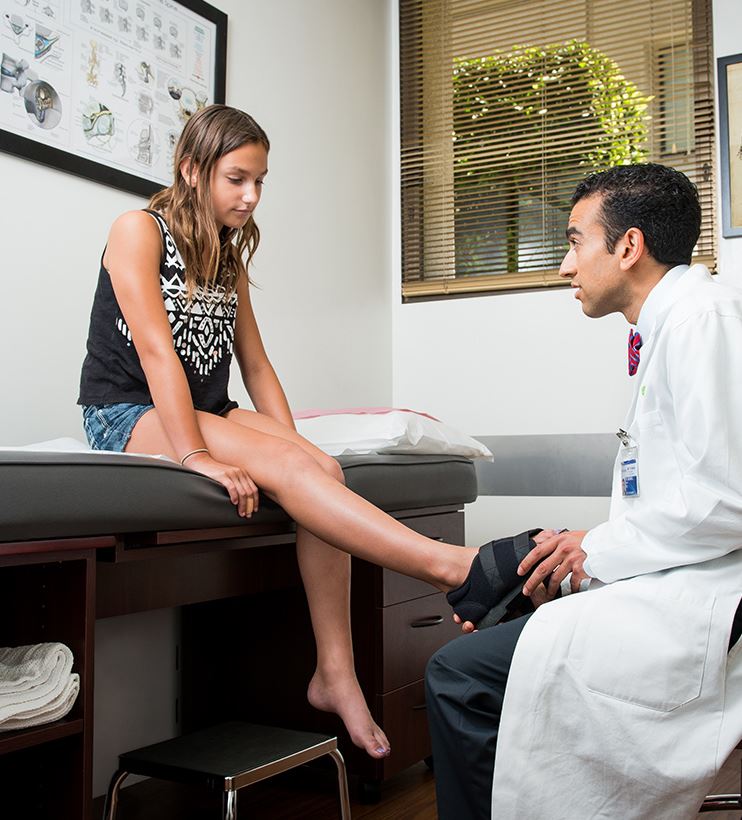

Foot & Ankle
OSS Has a Fellowship Trained Foot + Ankle Orthopedic Surgeon
Mark Mikhael, MD fellowship-trained orthopaedic surgeon in foot and ankle surgery, has the unique ability to effectively treat your foot and ankle condition even if the source of the foot problem is your knee, hip, or lower back.
Sprains and Strains of the Foot & Ankle
Watch this lecture given by Dr. Mark Mikhael who gives a thorough explanation of various foot and ankle injuries and treatments.
Non-Surgical Treatments
OSS doctors always start with the most conservative approach (in other words, the least invasive to your body and lifestyle) to help you ease the foot and ankle pain and improve how you move. Our doctors often prescribe most foot and ankle pain with active rest, ice or heat, prescription medications, splinting or bracing, injection therapy, and/or physical therapy.
Common Surgeries
Repair of Foot & Ankle Fractures
Sometimes casting or bracing is not enough to fix a broken bone in the hand or ankle if you have had a sudden injury. Surgery is often needed to realign the bones and hold them in place with plates and screws until they heal to help achieve the best outcome for you to get you back on your feet. Dr. Mikhael, at OSS, has many years of experience working in a regional hospital and trauma hospital treating patients with complex fractures of the foot and ankle.
Bone Growth or Deformity Correction
Correcting bunion, bunionette, claw toe, foot drop and hammer toe deformities are procedures that orthopaedic foot and ankle surgeons routinely do. Procedures commonly performed to correct bunions include scarf and akin osteotomy, and lapidus procedures. Other procedures include weil osteotomy for the second toe to correct claw toe deformities and fusion surgery of the PIP joint for hammer toes.
Bunion
In general, the common goals of most bunion surgeries include realigning the metatarsophalangeal (MTP) joint at the base of the big toe, relieving pain, and correcting the deformity. Because bunions vary in shape and size, there are different surgical procedures performed to correct them. In most cases, bunion surgery includes correcting the alignment of the bone and repairing the soft tissues around the big toe. Dr. Mikhael will talk with you about the type of surgery that will best correct your bunion.
Removal (excision) of a Cyst or Mass
This procedure is the removal of a cyst (ganglion) or a Morton’s neuroma in the foot and ankle. A ganglion is perhaps the most common soft tissue growth found in the foot or ankle. Ganglions are not cancerous. The cause of the ganglion is usually simple wear and tear on a particular tendon or joint. In the case of a mucinous cyst, there may be some degenerative joint disease (arthritis) in the last joint of the involved toe. The surgery involves removal of the mass.
Tendon & Ligament Repair
Tendons can become injured over time or from acute sports injuries. Surgery is often needed as tendons do not heal well on their own. The two ends of the tendon are identified and often sutured together to enhance healing and better restore strength. After surgery, a splint or cast is applied until there is sufficient healing to allow for walking in a boot or cast which is typically at 6 weeks.
Similarly, ligaments of the ankle can be repaired if they are torn with sports injuries or severe twisting injuries to the ankle. This involves the use of plastic anchors inserted into the bone. The suture tails attached to the anchor are then sewn into the torn ligament to hold it in place until it heals.
Common surgeries include: Achilles Tendon Lengthening, Achilles Tendon Repair, Haglund’s Deformity Repair (Resection Method), Peroneal tendon Repair and Ankle Ligament Reconstruction (ALR).
Flatfoot Reconstruction
Flatfoot reconstruction is a combination of surgical procedures that repair the foot’s ligaments and tendons and correct deformities of the bones to restore and support the arch. These adjustments can reduce pain and help the patient return to an active life. The type of procedures include: Calcaneal sliding osteotomy with lateral plate fixation, Kidner procedure, Lateral column lengthening (Evans Osteotomy), Subtalar implant and Triple arthrodesis.
Ankle Replacement Surgery
Arthritis can break down the joint in the ankle. There are different types of arthritis, which includes degenerative arthritis (wear from years of use), inflammatory arthritis (chronic joint disease), and post-traumatic arthritis (after fracture or broken bone in the ankle joint). Dr. Mikhael can evaluate your ankle and recommend what type of treatment you will need.
Fusion Surgery to Ease Foot or Ankle Pain From Arthritis
Arthrodesis is a surgery that fuses the bones of the joint completely, making one continuous bone out of two or more bones. The goal of the procedure is to reduce pain by eliminating motion in the arthritic joint.
During arthrodesis, Dr. Mikahel removes the damaged cartilage and then uses pins, plates and screws, or rods to fix the joint in a permanent position. Over time, the bones fuse or grow together, just like two ends of a broken bone grow together as it heals. By removing the joint, the source of pain is removed.
Common Problems
You may have one or more of these problems that is causing pain in your foot & ankle:
- A sudden injury (trauma such as a car accident or slip and fall) that causes a sprain or breaks and/or dislocates the bone(s)
- Sports related injuries
- Arthritis that affects the joints of the foot and ankle
- Tendon disorders of the foot and ankle (e.g., achilles tendonitis and tears)
- A deformity that develops in the bone or ankle joint (e.g., bunion, hammer toe, flat foot, bone spur)
- An infection or wound

Complete Approach to Surgery
OSS doctors use many techniques, so you stay safe in surgery. The OSS team will also help you with your recovery. Here is a preview of what our doctors and team do:
- Use minimally invasive surgical techniques in the surgery.
- Give you clear instructions on how to plan before and after your surgery so you are more at ease.
- Perform the procedures in well run, accredited surgery centers or in highly ranked hospitals.
- Work with physician anesthesiologists who are highly trained if your procedure requires general anesthesia.
- Manage the after-surgery short-term discomfort safely. We will also help you learn about the assistive devices (e.g., crutches, knee scooter).
- Monitor your recovery in the office and virtually.
- Get you home sooner. In fact, some foot and ankle surgeries can be “same day” surgeries, allowing you to return home later in the day. Of course, we offer the option of an overnight stay if you and your doctor determine it’s needed.
- Get you connected to our physical therapy team, so you rebuild your strength and mobility. Our doctors of physical therapy have excellent training and schooling.

Read What Our Patients Say
-
“This place is AMAZING!I I fractured my ankle and after being to about 4 different clinics and losing hope, this place saved me! Thank you Dr. Mikhael for performing my surgery and making me feel extremely comfortable with it! ”- Bryan
-
“I went to Dr. Mikhael for (an) ankle ligament and bone spur surgery. The entire process was smooth and easy as surgery can be. I also went to their physical therapy center for recovery. Everything there from Apryl to their PT assistants were ready and helpful. ”- Brian
-
“Now, November 2016, Dr. Mark Mikhael operated on my right foot. He also was a top surgeon. He spent alof of time going over everything with me before surgery in the office. My foot is healing quickly! ”- Janet L.
-
“This is my second time here. First time was for me with Dr Mikael. Second time was for my daughter - she went to see Dr Mikael too. She has a broken Fibula and Tibia. The wait time was spectacular today. Fast! His nurse / RN was on it!. As soon as he came to get us he says oh no! And immediately adjusted her crutches. Took us back and proceeded to take ... ”- Veronica V.
Trusted Medical Sources
To find out more about hand and wrist injuries, please visit American Academy of Orthopaedic Surgeons:
Description of the Foot & Ankle
The foot and ankle are the first parts of the body to accept weight when standing, walking and running. These two areas are very susceptible to adverse stresses in sports, activities, and varied walking surfaces which can lead to injury and foot and ankle pain. Similar to the hand and wrist, the foot and ankle are composed of a number of bones statically held together by ligaments and dynamically supported by muscles and tendons.

